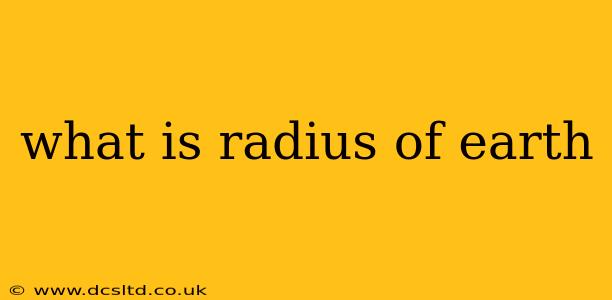The Earth isn't a perfect sphere; it's slightly flattened at the poles and bulging at the equator – a shape called an oblate spheroid. This means there's no single, universally accurate "radius." Instead, we use different types of radii to describe our planet's size:
What are the Different Types of Earth's Radius?
Several radii are used depending on the context and the level of precision needed:
-
Equatorial Radius: This is the distance from the Earth's center to the equator. It's the longest radius and measures approximately 6,378 kilometers (3,963 miles).
-
Polar Radius: This is the distance from the Earth's center to the North or South Pole. It's the shortest radius and measures approximately 6,357 kilometers (3,950 miles).
-
Mean Radius: This is an average radius, calculated to provide a single representative value. Several methods exist for calculating the mean radius, leading to slightly varying results. A commonly cited value is around 6,371 kilometers (3,959 miles).
Why is the Earth Not a Perfect Sphere?
The Earth's slightly oblate shape is primarily due to the centrifugal force created by its rotation. As the Earth spins, the material at the equator experiences a greater outward force, causing a bulge. This bulge is relatively small compared to the overall size of the Earth, but it's significant enough to require the use of different radii for precise measurements.
How is the Earth's Radius Measured?
Determining the Earth's radius has been a challenge throughout history. Early methods involved observing the shadow cast by the sun at different locations and employing basic geometry. Modern techniques utilize sophisticated satellite measurements and GPS technology for incredibly accurate measurements.
What are the Implications of Earth's Radius?
Understanding the Earth's radius is crucial for numerous scientific and technological applications, including:
-
Mapping and Navigation: Accurate radius measurements are essential for creating accurate maps, charting courses for ships and aircraft, and developing GPS systems.
-
Geodesy: This branch of science deals with the Earth's shape and dimensions, relying heavily on precise radius measurements.
-
Astronomy and Astrophysics: Understanding the Earth's size and shape provides context for comparing our planet to other celestial bodies.
-
Space Exploration: Precise radius measurements are vital for calculating satellite orbits and planning space missions.
How Accurate are these Measurements?
Modern techniques allow for highly precise measurements of the Earth's radii. The values mentioned above represent averages and may vary slightly depending on the data and methodology used. The discrepancies are very small, typically within a kilometer or so, and inconsequential for most applications.
Frequently Asked Questions (Based on common search queries)
What is the average radius of the earth in miles?
The average radius of the Earth is approximately 3,959 miles. However, remember that this is a mean radius and the actual distance varies depending on location.
What is the difference between the equatorial and polar radius?
The difference between the equatorial and polar radius is approximately 21 kilometers (13 miles). The equatorial radius is longer due to the Earth's centrifugal force.
How was the radius of the Earth first measured?
Early attempts to measure the Earth's radius employed methods such as observing shadows cast by the sun at different locations and utilizing basic geometrical principles. These methods, while less precise than modern techniques, provided foundational estimates of the Earth's size.
Is the Earth's radius constantly changing?
The Earth's radius is not static. It undergoes minute changes due to various geological processes and the effects of plate tectonics, though these changes are extremely small in the context of the Earth's overall size.
This comprehensive overview should answer most questions related to the Earth's radius. Remember that the exact figure depends on the type of radius being considered and the level of precision required.
